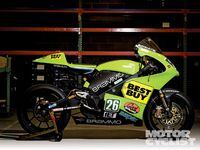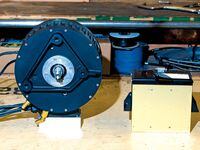Riding a motorcycle is often described as flying without leaving the ground, and no other sentiment as accurately describes a ride on Brammo's all-electric Enertia TTR racebike. Soaring along at 80 mph, the utter peacefulness is remarkable. Speed masks the humming motor and whirring chain, so the wind flowing past your helmet is all you hear. There isn't the slightest vibration or feedback from the motor-you don't even know it's on. The only sensation is pure, unadulterated forward motion, like sailing through the air on a glider. It's a novel riding experience-one that many of us have dreamed about since we first started riding.
Brammo didn't set out to reinvent the motorcycle. In fact, company CEO Craig Bramscher didn't set out to make motorcycles at all. After amassing a small fortune selling eCommerce solutions, Bramscher decided to build the ultimate American supercar. The Brammo Rogue GT debuted just in time for last year's oil/economic crisis-dreadful timing for an 850-horsepower, 3-mpg V12.
So Bramscher did a corporate 180, selling the Rogue name to Nissan for its new compact SUV and using the profits to fund a more market-savvy venture: building a zero-emissions, plug-in motorcycle. One of Bramscher's side ventures was building Ariel Atom sports cars under license in his Ashland, Oregon, factory, and his team had investigated an electric-powered Atom. Available electric technology was judged inadequate for that application, but it seemed perfect for a two-wheeled commuter vehicle-and the Brammo Enertia was born.
Racing wasn't on Brammo's radar until late last year, when the company's director of product development, Brian Wismann, heard about the zero-emissions TTXGP at the Isle of Man. The decision was made in early January-just five months before the race-to construct an entry. A small team led by Wismann (Brammo's first employee, and designer of the Rogue GT) and lead engineer Aaron Bland began working after hours and on weekends to convert the pedestrian Enertia into a proper racing machine.
Still, Brammo wanted the TTR racer to be as close to the production Enertia as possible. "We wanted to build a racing machine relevant to the product we offer the public," Wismann says. "We wanted to focus on improving our design concepts for a production bike, and to work with developing technology with the same suppliers that support our production bike."
The production Enertia chassis, designed to navigate city streets at commuter speeds, was hardly suitable for negotiating the TT course at race pace. Needing to develop a race-ready chassis as quickly and cheaply as possible, the Brammo boys benchmarked a Triumph Daytona 675 and modified an Enertia frame to mimic the Triumph's geometry. The racebike even borrows some D675 components, including the triple clamps and fork legs.
The all-electric powertrain came straight from the Enertia's existing supply chain, using beefed-up ("overvolved" in Brammo-speak) versions of the same electric motor, digital controller and battery-management system. The battery pack, comprising eight lithium-cobalt batteries, was built by Brammo specifically for the racing application.
Brammo's design strategy diverged significantly from its TTXGP competition. Other entries made two or three times as much power, and weighed almost twice as much, as the 30-horse, 370-pound TTR. "We didn't set out to build an electric MotoGP bike," Wismann explains. "Our goal was to be as efficient as possible. More power requires more batteries, and batteries are expensive. If we can find better performance with fewer batteries, it brings cost down-an important concern for our production bike." This strategy proved sound: Brammo finished third in the inaugural TTXGP, ahead of the high-powered, 600-plus-pound Mission Motors and MotoCzysz machines.
We rode the Enertia TTR just days after it returned to Oregon, with the same setup that put Scotsman Mark Buckley on the podium at the Isle of Man. From the tall, 34.5-inch saddle it feels indistinguishable from any other racebike with high rearsets and clip-ons mounted midway between the triple clamps. The starting procedure, however, is completely different. Flip the accessory power switch under the tail to wake up the gauges. Reset the oversized kill switches on the tank and tailsection (required by TTXGP rules), then depress the laptop-like main power button in the center of the tank. Finally, flip one more kill switch on the bar to activate the throttle. Keeping this last switch off anytime the bike is not in motion prevents you-or anyone else within arm's reach-from "whiskey-throttling" the silent machine out from underneath you.
There is no clutch or transmission; the direct-drive TTR is twist-and-go, like a scooter. Turn the throttle and the bike spirits away like a magic carpet. There is no vibration or driveline lash; a soft hum (like a ceiling fan turning on) and a bit of chain noise is the only indication that you are straddling a machine. Acceleration is brisk but hardly fierce. Theoretically, all 53 lb.-ft. of torque could be available from zero rpm, but the digital controller is programmed to deliver much less, both to save energy and to make the clutchless bike easier to launch.
A conventional twistgrip, connected by a cable to a wiper-equipped throttle mechanism, translates wrist motion into current draw. Eerily smooth throttle response recalls a rheostat, because that's essentially what it is. Acceleration is very predictable thanks to a linear throttle map that maintains a 1:1 ratio between throttle opening and power increase. "We didn't program any progressivity into the map at all," Wismann says. "We found it best to leave that up to the rider."
Given electric power's instant-on availability and the advanced processing capability of the digital controller, power delivery is almost infinitely adjustable. Tuned for the TTXGP, acceleration was decidedly soft. The TTR's battery pack holds the approximate energy equivalent of three quarters of a gallon of gasoline, which it used to propel itself around the demanding, 37.73-mile Snaefell Mountain course. Efficiency-not outright acceleration-was the goal. The bike could be reprogrammed to accelerate quicker at the cost of greatly reduced battery life. As is, we put around 40 miles on the TTR, in mixed riding conditions, before the batteries discharged completely.
The only time we felt we needed more robust acceleration was in tight, knee-down corners, where more power would have helped pick the bike up post-apex. The TTR does not like to be flicked on its side-better to ride it like a 125cc GP bike, choosing fast, flowing lines. Corner entries can be tricky as well. There is no engine braking whatsoever, so you rely entirely on the binders to load the front end. Without any back-torque, the bike seems to speed up when you let off the brakes, which is startling the first few times. Better to have your entry speed set before you turn in.
An electric motor's power curve is the opposite of most internal-combustion engines. Max torque is available from zero rpm, and declines (eventually rapidly) as you approach the rev limit. The TTR, for example, loses almost 30 percent of its peak power by the 6000-rpm redline. As a result, the bike feels significantly more powerful from a standing start than during roll-ons. Wismann says this is a programmable variable as well. Increasing the voltage draw at the point where output begins to drop would mask the power fall-off, but would also cause a corresponding reduction in battery life. Adding a multi-speed transmission also would improve this situation, letting the rider upshift to reduce rpm-though that would be a costly and time-consuming solution.
With identical geometry and weight, the TTR handles like a well-prepped Daytona 675 racebike. Steering is neutral and lightning-fast, more akin to a 250cc GP bike than any 600. Unlike an internal-combustion motorcycle, there's no 30-pound crankshaft spinning at 15,000 rpm and creating massive gyroscopic forces that must be overcome. In fact, excepting the motor's tiny plastic rotor, there are no rotating or reciprocating parts at all. The entire powertrain is essentially dead weight that doesn't exert any dynamic force on the chassis. Line adjustments and corrections are met with little resistance and mid-corner stability is excellent, the latter aided by a compliant Elka shock and Triumph fork fitted with Traxxion Dynamics' mega-bucks AK-Gas pressurized cartridge kit. Even heavy braking-more inevitability than possibility with the overpowering Brembo Monoblocs-didn't make the chassis do anything untoward.
The TTR and its ilk won't replace internal-combustion motorcycles just yet. Racy looks aside, it's still more scooter that sportbike. It's certainly a compelling machine, though, and one that offers enormous promise once battery technology advances and fewer tuning compromises will be required for optimum performance. And there is a very real possibility that Brammo will bring a true electric sportbike to market in the near future. "A production TTR is certainly achievable," Wismann says. "The question is, at what cost? Right now, the cost would be too high relative to the performance offered. But give it a couple years, when the energy density of batteries increases and cost per unit comes down, and we will be riding something even better than this on the street."
Hard Parts
Inside An Electric Superbike
Motor
A single AC motor located directly in front of the rear wheel powers the Enertia TTR. Manufactured by Perm Motor in Germany, the compact motor is a brushless, permanent-magnet design that is more efficient and durable than the simpler, less-expensive, brush-type motors most other TTXGP entries used. The peak efficiency rating is 94 percent (compared to approximately 25 percent efficiency for the very best internal-combustion engines), and the motor is liquid-cooled to minimize heat-related losses, with a tiny radiator mounted below the headstock. The motor's continuous-power rating is 20 kW, with a peak power rating of 30 kW. In TTXGP tune, this translates to 30 horsepower and 53 lb.-ft. of torque at the rear wheel. Custom sideplates allow the motor to be mounted as a stressed member, and there is no gearbox or primary drive; the drive sprocket mounts directly to the motor output shaft. A cush drive on the rear hub minimizes driveline lash.
Electronic Controls
The TTR's digital controller (the large, finned-aluminum box hung beneath the battery pack) monitors both throttle input and rear-wheel speed, then uses that information to transmit power from the batteries to the motor. Made by DMC (Digital Motor Control) in Germany, this is a beefed-up version of the same highly tunable control unit used on the production Enertia. Manipulating the controller's voltage and current settings, along with other more discreet parameters, creates the "throttle map" that determines the rate at which available torque is metered to the rear tire. The controller is currently air-cooled, but Brammo says it will be liquid-cooled in the next version, since the unit is essentially operating at its thermal limit. A stand-alone, 12-volt electrical system, located under the tailsection, powers the instrument cluster and other conventional electronic components.
Batteries
The production Enertia carries six lithium-iron-phosphate batteries. The Enertia TTR racer carries eight custom racing batteries that use lithium-cobalt chemistry, similar to the Tesla electric supercar. Lithium-cobalt chemistry delivers superior energy density at the cost of long-term stability, making it appropriate for racing but less desirable for street applications. On streetbikes, countless repeated charging cycles make chemical stability more valuable than outright performance. The TTR's 100-volt/90-amp battery stack can deliver as much as 46 kWh to the motor-more than either the present motor or controller can process without overheating, TTXGP experience shows. An integrated battery-management system located under the fairing upper functions similarly to an ECU, only instead of monitoring fueling and ignition timing, it manages the amount of current delivered by the batteries and the charge levels of each individual battery cell.
Chassis
The TTR frame uses the same extruded-aluminum main rails as the production Enertia, mated to a much stronger and stiffer steering head. Custom-machined outer motor plates are welded directly to the bottom of the main spars, so the solid-mounted motor functions as a stressed member for added rigidity. A custom chromoly swingarm pivots directly off the motor plates. A one-off subframe, consisting of a bonded and riveted extension bolted to a machined base, supports the rider. The frame width is identical between the production and the racing machines: Enertia batteries fit in the TTR, and vice-versa.
Suspension/Brakes
Running gear is a mix of bits borrowed from a donor Triumph Daytona 675 and the best parts available from the existing Enertia supply chain. Elka, which supplies the damper for the production Enertia, contributed the fully adjustable, piggyback-reservoir shock. Relatively low power and slower speeds from the electric bike mean less complicated loads on the rear suspension, so Brammo chose to mount the shock directly without a linkage. Triumph forks have been upgraded with Traxxion Dynamics' $2500 AK-Gas pressurized cartridges for remarkably predictable and stable front-end control. Another Enertia partner, Brembo, provided a pair of its massive Monobloc calipers that are frankly overkill for a machine of this size and speed. One caliper would be plenty. Forged-magnesium Marchesini 17-inch wheels slash rotating mass, while an hlins hydraulic steering damper stabilizes the front end.
Tech Spec
Contact
Brammo Inc.
550 Clover Ln.
Ashland, OR 97520
541.482.9555
www.brammo.com
Verdict 3 stars out of 5
Intelligent, innovative and impressive considering the current state of electric motorcycle technology.






















/cloudfront-us-east-1.images.arcpublishing.com/octane/FZXHNOQRNVA3BIDWAF46TSX6I4.jpg)
/cloudfront-us-east-1.images.arcpublishing.com/octane/JRSFLB2645FVNOQAZCKC5LNJY4.jpg)
/cloudfront-us-east-1.images.arcpublishing.com/octane/ITNLTIU5QZARHO733XP4EBTNVE.jpg)
/cloudfront-us-east-1.images.arcpublishing.com/octane/VZZXJQ6U3FESFPZCBVXKFSUG4A.jpg)
/cloudfront-us-east-1.images.arcpublishing.com/octane/QCZEPHQAMRHZPLHTDJBIJVWL3M.jpg)
/cloudfront-us-east-1.images.arcpublishing.com/octane/HXOUJXQWA5HBHGRO3EMJIGFMVI.jpg)

/cloudfront-us-east-1.images.arcpublishing.com/octane/3TIWWRV4JBBOLDVGRYECVVTA7Y.jpg)
/cloudfront-us-east-1.images.arcpublishing.com/octane/KIX5O23D5NAIBGFXBN3327DKZU.jpg)
/cloudfront-us-east-1.images.arcpublishing.com/octane/7GJYDUIPXRGMTMQKN6ONYOLBOU.jpg)
/cloudfront-us-east-1.images.arcpublishing.com/octane/MUQLOVLL2ZDGFH25ILABNBXKTI.jpg)
/cloudfront-us-east-1.images.arcpublishing.com/octane/TNOU5DNE2BC57MFPMGN2EIDXAM.jpg)
/cloudfront-us-east-1.images.arcpublishing.com/octane/GTCXACQGJ5HAPDTGWUQKDEH44E.jpg)
/cloudfront-us-east-1.images.arcpublishing.com/octane/S35YGSEMEZB4BLTDJTSZPF4GLA.jpg)
/cloudfront-us-east-1.images.arcpublishing.com/octane/5UOT6HPX2JFMRJAX6EH45AR4MQ.jpg)
/cloudfront-us-east-1.images.arcpublishing.com/octane/OKWOJWAKP5EP3OACCRRWPCIX2Q.jpg)
/cloudfront-us-east-1.images.arcpublishing.com/octane/2WF3SCE3NFBQXLDNJM7KMXA45E.jpg)
/cloudfront-us-east-1.images.arcpublishing.com/octane/G4MG6OUCJNBSHIS2MVVOTPX65E.jpg)
/cloudfront-us-east-1.images.arcpublishing.com/octane/IIGGWFOTOJGB7DB6DGBXCCMTDY.jpg)
/cloudfront-us-east-1.images.arcpublishing.com/octane/QSTCM6AVEZA5JJBUXNIQ3DSOF4.jpg)
/cloudfront-us-east-1.images.arcpublishing.com/octane/U4I7G625B5DMLF2DVIJDFZVV6M.jpg)
/cloudfront-us-east-1.images.arcpublishing.com/octane/B6XD6LS6IVCQPIU6HXDJSM3FHY.jpg)
/cloudfront-us-east-1.images.arcpublishing.com/octane/ICL63FEDDRDTTMINYICCEYGMDA.jpg)
/cloudfront-us-east-1.images.arcpublishing.com/octane/FCGZHQXRBZFLBAPC5SDIQLVF4I.jpg)